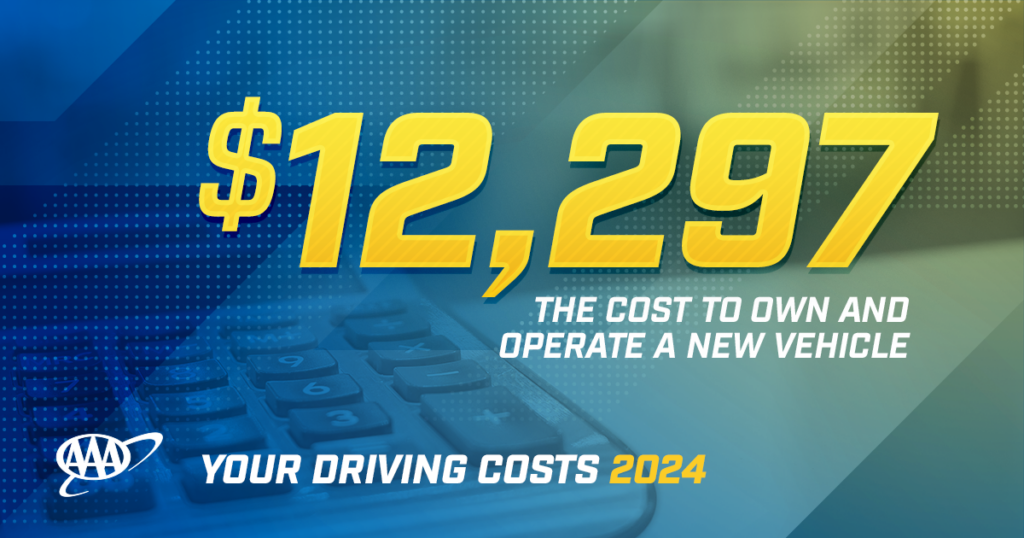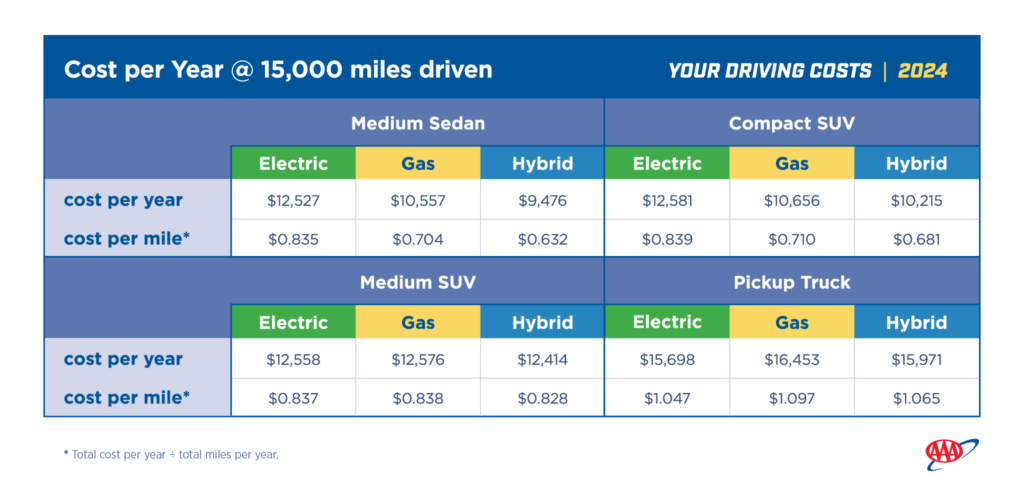
AAA your driving costs: The price of new car ownership continues to climb
Rising depreciation and finance charges impact consumers interested in buying new
This year’s Your Driving Cost (YDC) study reveals that the total cost to own and operate a new vehicle is $12,297 or $1,024.71 monthly, an increase of $115 from 2023.
The leading cost culprits for buyers are depreciation and finance charges. With automakers adding more vehicle choices with major redesigns, AAA advises buyers to consider various factors associated with owning and operating a new vehicle to fully understand ownership costs.
“Buying a new car can be exciting,” said Greg Brannon, AAA’s director of automotive research. “But consumers should fully understand all the costs of owning and operating a new vehicle from purchase to resale.”
Depreciation, the difference between the car’s value upon purchase and when sold, is the most significant cost category associated with vehicle ownership in this year’s analysis. On average, cars in this year’s YDC lose a staggering $4,680 annually. The popularity of oversized vehicles with cutting-edge features has led to an increase in new car prices, which results in higher depreciation costs.

Other factors driving new ownership costs:
- Car Prices—The sales-weighted average manufacturer’s suggested retail price (MSRP) for new vehicles in the study is $38,883, an increase of 0.7% over last year. It’s important to note the MSRP may not always reflect the actual purchase price and can vary based on demand. The average MSRP for each vehicle category is weighted based on its share of the total vehicle sales. This means higher-selling categories, such as pick-up trucks, have a larger impact on the average value.
- Finance Charges—A higher sticker price directly impacts finance costs, with this year’s vehicles incurring an average annual finance charge of $1,332, a 6% increase from the previous year. *Please note: The sticker price increase may be due to vehicles being replaced in YDC.
This year, EVs have the second-highest total ownership costs due to depreciation, purchase prices, and finance charges. Preferences have shifted to more expensive and larger EVs, resulting in growth in these cost categories. EVs have the lowest fuel cost of any vehicle type, based on a national average electricity price of 15.9 cents per kilowatt hour (kWh). Plus, because of their design and powertrain, EVs have the lowest maintenance costs.
Hybrid vehicles have the second lowest total ownership costs behind small sedans. They benefit from excellent fuel economy and low maintenance costs and rank near the middle in depreciation, financing, and insurance costs. According to this year’s EV consumer sentiment survey, one in three U.S. adults (31%) say they would be “very likely” or “likely” to buy a Hybrid.
“Hybrid vehicles are a reasonable, affordable option for those who want to try the benefits of electrification,” said Brannon. “Hybrids benefit from excellent fuel economy, low maintenance costs, depreciation, and insurance – making them an affordable option for car buyers.”
This year, AAA expanded YDC by comparing top-selling EVs and Hybrid models in four popular vehicle categories – medium sedan, compact SUV, medium SUV, and pickup truck. Over the past few years, their growth in popularity has been a significant trend, requiring automakers to expand their lineups to include more appealing models. This bonus analysis will give consumers a snapshot of ownership costs for select EV and Hybrid models compared to their gas-powered counterparts. Learn more.

*Note: Not all categories and models are available for analysis and cannot be directly compared to the average ownership total. Refer to the methodology for additional background.
Car Buying Advice
With higher purchase prices impacting other cost categories, it’s important to remember these car-buying tips when researching all options:
- Create a monthly or annual budget and factor in ownership and operating costs before purchase.
- Keep each transaction and negotiation separate from the other – the cost of the car, the finance rate, and the trade-in value.
- Obtain pre-approval from a financial institution (e.g., Bank, Credit Union, AAA, etc.) before discussing finance rates with the car dealer to ensure you get the best lending rate available to you.
- There are quite a few options (online and in-store) available to consumers when considering where to buy a used vehicle besides a dealership. Visit your local AAA, which may offer discounts for members.
Additional AAA Support:
- Your Driving Costs calculator: Customizable digital tool that offers cost analyses for specific vehicles by category, new and used cars (up to five model years back).
- AAA Car Guide: Annual guide that ranks and rates vehicles with the latest automotive technology.
- AAA’s Car Buying Program: Comparisons for consumers to use while car shopping and buying.
- EV 101 (Digital Buyer’s Guide): Resource and educational guide for consumers to use while electric vehicle shopping and buying.
- Repair Cost Calculator: Repair costs breakdown for parts and labor, including AAA member discounts available when visiting AAA Approved Auto Repair facilities.





